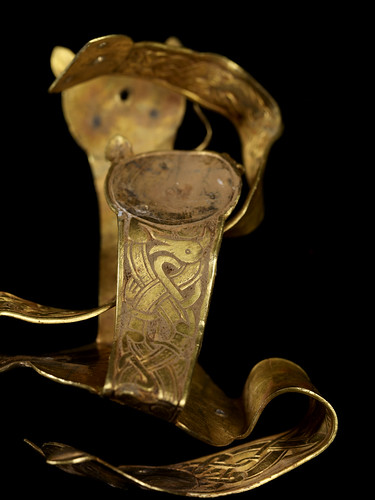The largest collection of beautiful quality gold and silver treasures from the seventh century Anglo-Saxon period has been discovered in a field by a plucky metal detectorist, who’s previous plights had bought up no more than a Roman horse harness. Over 1,500 pieces have been found in a private field in Staffordshire, amounting to over 5kg in gold and 1.3kg in silver.
The report of this find comes just weeks after the news of 10,000 Roman coins in neighbouring Shropshire being discovered, as well as news of the Vale of York hoard being purchased by the British Museum for over 1 million. So it’d appear that owning a metal detector could be a worthy investment!Terry Herbert, the amateur treasure hunter who lives alone in his council flat, claiming disability benefits, now stands to claim a share of at least a 1 million finder’s reward as local museums raise funds to keep the hoard in the county.
 The seventh century represented the Dark Ages for the country – England didn’t exist yet, and instead the land was made up of several small tribal kingdoms who were often in a state of war with one another. The spot where the Hoard lay for the past millennium and a half is in the heart of the Anglo-Saxon Kingdom of Mercia, although the exact position has not been revealed for security reasons.
The seventh century represented the Dark Ages for the country – England didn’t exist yet, and instead the land was made up of several small tribal kingdoms who were often in a state of war with one another. The spot where the Hoard lay for the past millennium and a half is in the heart of the Anglo-Saxon Kingdom of Mercia, although the exact position has not been revealed for security reasons.
Christianity, first introduced to the country by the Romans and then forced to near extinction, had returned to the land and is evident in some of the finds in the hoard, which amongst weaponry and helmets, included biblical inscriptions and Christian crosses.
Staffordshire local history collections officer and specialist in Saxo-Norman Staffordshire pottery Deb Klemperer was moved to tears by the find. She said “The Dark Ages in Staffordshire have never looked so bright nor so beautiful. This incredible find will sit alongside numerous collections of archaeological remains which are interpreted within the context of the geological, natural and social history of our area.”
The principal pieces of the find will be shown at the Birmingham Museum from now until the 13th October, after which they will be taken to the British Museum in London for valuation.
